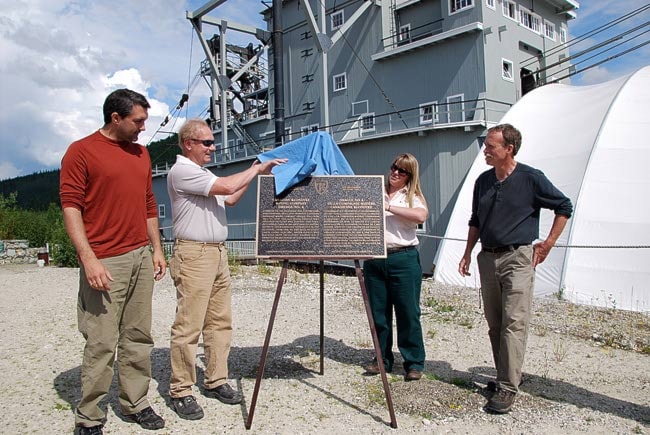Bonanza Creek
A pall of controversy hung over the otherwise joyful celebrations as Dredge Number 4 National Historic Site received recognition as a significant historical engineering work this past weekend near Dawson City.
A special event was held on Saturday at the site of the dredge, which is the major visitor attraction on Bonanza Creek. The weather cooperated and the sun shone down through parting clouds as visitors and guests panned for gold and ate hot dogs and cupcakes. People explored the interior of the largest wooden-hulled, bucket-line dredge that ever operated in North America.
The work of replacing rotten port-bow timbers was underway during the day, and the air was permeated with the sweet smell of pine tar and linseed oil being applied by workers to preserve the replacement beams. Members of the restoration team were on hand to answer queries about the work, and Parks Canada interpreters were stationed throughout the vessel to answer the questions of the eager visitors crowding on board for a glimpse of the future no-mans-land.
At 2 p.m., a crowd of more than 150 people was called to attention as David Rohatensky, the superintendent for national historic sites in the Dawson City district, explained the purpose of the gathering.
The dredge and its associated works, including an extensive power distribution system and industrial support facilities called the Yukon Ditch, has been recognized by the Canadian Society of Civil Engineers as a significant national engineering work. Other works in the Yukon recognized by the society include the White Pass and Yukon Route Railroad (2004), and the Alaska Highway (1996).
After brief introductory remarks, Rohatensky turned the floor over to Pat Habiluk, the engineer whose association with the dredge spans a quarter century and includes the moving of the dredge to its current location in 1991 and 1992. Habiluk spoke on behalf of Ken Johnson, the civil engineer who nominated the dredge for recognition and championed its plaquing. Johnson was unable to attend the ceremony.
After Habiluk’s brief comments about the significance of the dredge and a thank-you to Parks Canada, Rohatensky called upon Habiluk, Klondike MLA Sandy Silver, and Parks Canada employees Carrie Docken and Hugh Copland to unveil the plaque.
After the unveiling, a member of the audience, who identified himself as a resident of Whitehorse, drew the attention of the audience to the irony of honouring the dredge in this way when the plan is to padlock the structure at the end of the season.
Silver responded stating that a petition would soon be in circulation regarding this issue.
The decision of the federal government to slash operations of Parks Canada by nearly one-third means that the dredge will no longer be open to the public for interpreted tours after the end of the season. The cuts include the entire curatorial staff who have been responsible for the documentation and care of thousands of artifacts. These artifacts were removed from the dredge for safekeeping after more than five metres of silt were removed from the dredge hull in 1991.
The cuts raise serious questions about the commemoration of the dredge during 2013, which will be the centennial of its construction. The building of the dredge by Joe Boyle’s Canadian Klondyke Mining Company was completed in 1913, after which it mined its way up the Klondike valley to the mouth of Hunker Creek. In 1941, the dredge was rebuilt on Bonanza Creek, and continued to operate until it shut down permanently in 1959.
The relocation of the 3,000-tonne dredge onto its current foundation by Canadian Construction Engineering Unit Number 1 of the Canadian Armed Forces in 1991 and 1992 marked the beginning of current restoration activities that were evident even during the Saturday event.
Various foreign visitors attending the celebration expressed their disappointment with the closure before hustling off to see the inner workings before the doors are locked for good.
The cuts and following closures have elicited a storm of protest. Most recently, the Tourism Industry Association of Yukon has contested a statement made by Yukon MP Ryan Leef that downplays the impact of the cuts and closures on the industry. TIAY disagrees, stating instead that there will be major consequences for tourism operators.
Despite the gloomy forecast, Mother Nature blessed the site with decent weather that afternoon and curious visitors exploring the nooks and crannies had a fine time.
